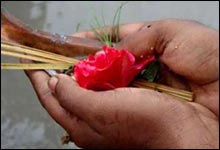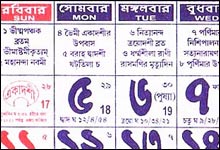Poila Baishakh

HISTORY OF BENGALI CALENDER
The Bengali calendar or Bangabda is maintained in Bangladesh, West Bengal, Assam and Tripura. It is according to the Bhaskar (Sun) Era, pioneered by Emperor Akbar in 1584 AD.
The calendar was initially named as Tarikh-e-Elahi. The months of the Bengali year (or Tarikh-e-Elahi) were primarily recognized as Karwadin, Ardi, 'Vihisu, Khordad, Teer, Amardad, Shahriar, Aban, Azur, Dai, Baham and Iskander Miz. It is assumed that the present names of the months are according to the names of the stars. This is introduced from the Shakabda in 78 A.D. to honor the sovereignty of the Shaka.
THE NAMES OF THE MONTHS DERIVING FROM STARS
1. Baishakh from the star Bishakha
2. Jiashthya from Jaishtha
3. Ashara from Shar
4. Sraban from Srabani
5. Bhadra from Bhadrapada
6. Ashwin from Aswaini
7. Kartik from Kartika
8. Agrahayon from Agraihon
9. Poush from Poushya
10. Magh from Magha
11. Falgun from Falguni, and
12. Chaitra from Chitra stars.
Some argue that, Shashanka, king of Bengal, introduced Bengali calendar to memorialize his invasion of Assam.
CELEBRATION OF NABABARSHA
Naba Barsha (Poila Baisakh) is a famous occasion for Bengalis. It is the first day of the first month of Bengali year. Naba Barsha ushers a new opening, a new anticipation, filled with delight, happiness and wealth. To greet the New Year, Bengalis beautify their homes by drawing attractive and colorful rangolis on the doorway with minced rice, which is identified in Bengal as "Alpana". In the center of the drawing, a red clay pot with a white ‘Swastika’ is placed. The pot is full with holy water and mango leaves and it is identified as a blessed one by the Bengalis. They offer puja to lord Ganesha and goddess Laxmi for the welfare and affluence of the families.

Ladies wear conventional sari and decorate their hair with colourful flowers and men wear dhoti kurta. They all participate in the processions named 'Prabhat Pheri' early in the morning to welcome the first day of the year.The day is celebrated with feast and cultural activities. Naba-Barsha is also popular among the tribal people in the Hilly regions. New Year is especially colorful in the villages, with a day of sweets and special foods, music, dance and enjoyment.The grass, the skies, trees – every natural object seems beautiful and glows with delight and cheerfulness. To each and every Bengali, it is an occasion of joviality to be enjoyed with immense merriment, in all possible way. Special dishes are prepared on this day.
NEW BUSINESS VENTURE
Nababarsha or Poila Baishakh is also considered to be the most auspicious month for marriages and new business venture. On this very day businesspersons and traders buy their new accounting books to maintain their new financial records named as ‘Haalkhata’, swastiks are drawn on it. All the previous dues are cleared by the customers. And in turn of it shop owners dish up delicious sweets and drinks to them and restore the business connection with them.
CELEBRATION IN DHAKA
This celebration is recognized as the Poila Baisakh in Bangladesh and it is a national holiday there. This festivity is directly associated with pastoral life in Bengal. This is one rustic fiesta which turns out an enormous festival, particularly in Dhaka.
BOISHAKHI FAIR
Boishakhi fairs are organized on this very day. A variety of rural goods, conventional handwork items, additionally different foodstuffs and sweets are put up for sale here. Boishakhi fairs also offer amusements, such as, jatra (conventional dramas), pala gan, kobigan, jarigan, gambhira gan, gazir gan and alkap gan. The other appeal of these fairs are puppet shows and merry-go-rounds.
The most colourful celebration on this occasion held in Dhaka. People assemble below the banyan tree at Ramna Park to welcome the New Year with Rabindranath Tagore's renowned song, ‘Esho, he Boishakh, Esho Esho’ (Come, O Boishakh, Come, Come). A same ceremony is also celebrated at the Institute of Fine Arts, University of Dhaka. Students and teachers of the institution carry out a lively procession around the University campus.
The last day of the last month of the Bengali Year, ‘Chaitra-Sankranti’, which says farewell to the previous year, celebrate with the same grandeur.




